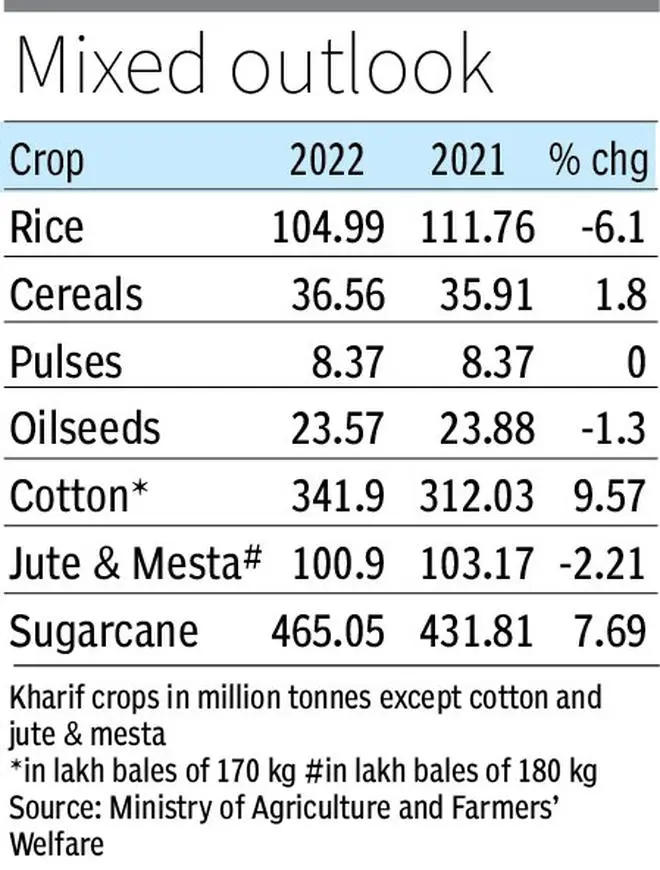India’s kharif rice and overall foodgrain production has been estimated lower this year by over 6 million tonnes (mt) each compared with the last year by the Ministry of Agriculture and Farmers Welfare in its first advance estimate released today (Wednesday).
The fall in the production is mainly in view of 17 per cent deficient rainfall during the ongoing monsoon season this year in eastern and north-eastern parts of the country. The north-western parts have received 4 per cent deficient rainfall, which has impacted the production of crops such as tur and oilseeds.
According to the estimate, kharif rice production has been pegged 6.77 million tonnes (mt) lower this crop year (July 2022-June 2023) at 104.99 mt compared with last year. Foodgrain output is projected to drop by 6.12 mt to 149.92 mt.
Nutri-cereals pulses
The Agriculture Ministry, releasing the estimate, projected nutri-cereals production at 36.56 mt (35.91 mt) and pulses output at 8.37 mt (8.37 mt).
Nutri-cereals production is up mainly on the back of a record maize output. Maize output is seen at 23.10 mt against 22.63 mt a year ago. Farmers went it for higher maize acreage in view of its prices ruling at over ₹2,200 a quintal last season, mainly on demand from the poultry sector.
However, a lower coverage of jowar (down 4.6 per cent) and ragi (down 10.7 per cent) has resulted in a meagre 1.8 per cent increase in nutri-cereals production.

Production of pulses is estimated unchanged at 8.37 mt compared with last year. The unchanged production is despite a 4.1 per cent drop in the coverage of pulses crop with the area declining under tur (arhar, pigeon pea) by 4.6 per cent, urad (black matpe) by 3.9 per cent and moong (green gram) by 4 per cent.
The Ministry said among pulses, tur production is pegged at 3.89 mt against 4.34 mt a year ago.
Oilseeds lower
Kharif oilseeds production has been projected at 23.57 mt against 23.88 mt a year ago. It is down 1.3 per cent mainly since groundnut output is seen at 8.37 mt versus 8.375 mt a year ago. The soyabean crop has been pegged at 12.89 mt compared with about 13 mt a year ago.
The drop in both these oilseeds crop output is mainly in view of their coverage slipping by 7.3 per cent and 0.1 per cent respectively. Madhya Pradesh, the hub of soyabean, saw farmers switching over to pulses from soyabean this year, in away affecting the overall production.
A record export of 11.2 mt of sugar and diversion of over 3 mt of sugar output to ethanol have buoyed sugarcane farmers that this year they have planted the crop on a record 55.65 lakh hectares. As a result, sugarcane production is pegged at a record 465.05 million tonnes.
Cotton rebounds
Cotton output is expected to rebound from last year’s experience of unseasonal rain affecting the crop. Production this year is seen at 341.9 lakh bales (170 kg) against 312.03 lakh bales last year. Record prices for cotton, topping ₹1 lakh a candy (356 kg) have helped increase the area under the fibre crop by 7.5 per cent this year.
Jute and mesta production is pegged lower at 100.9 lakh bales (180 kg each) against 103.17 lakh bales as the coverage slipped 0.2 per cent and the growing areas were affected by deficient rainfall.
The Ministry said overall kharif production is better than the average of the last five years, which is seen as an effort to assuage the market that the situation is under control.
The Government, on its part, has taken steps to overcome the tricky problem of lower rice production by curbing its exports, while allowing imports of pulses and oilseeds.







Comments
Comments have to be in English, and in full sentences. They cannot be abusive or personal. Please abide by our community guidelines for posting your comments.
We have migrated to a new commenting platform. If you are already a registered user of TheHindu Businessline and logged in, you may continue to engage with our articles. If you do not have an account please register and login to post comments. Users can access their older comments by logging into their accounts on Vuukle.